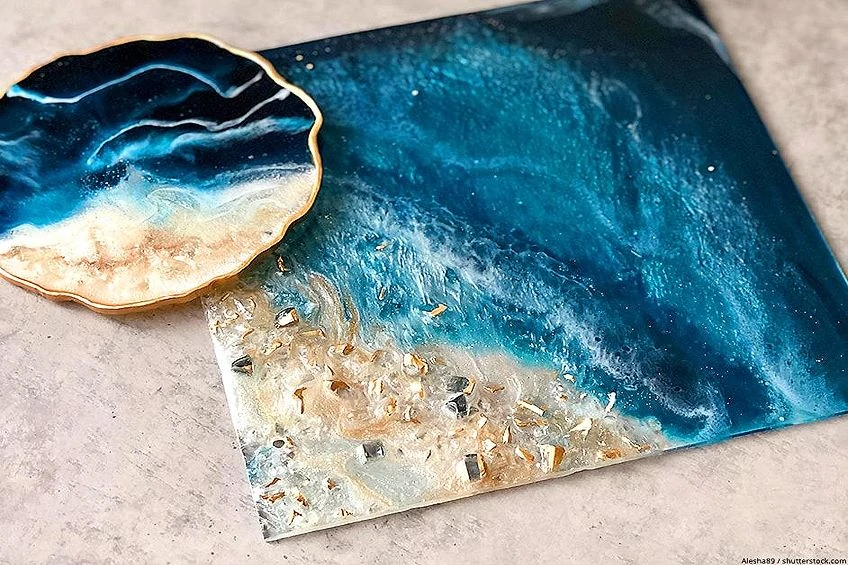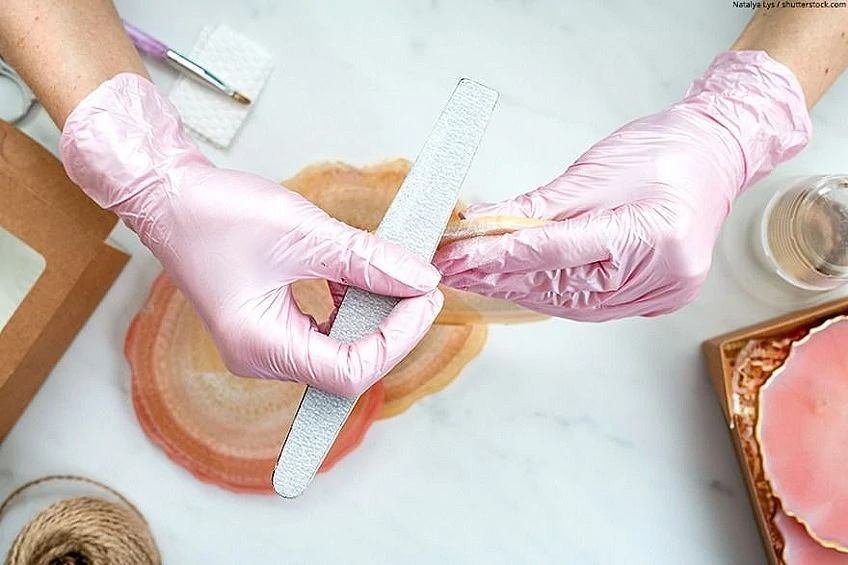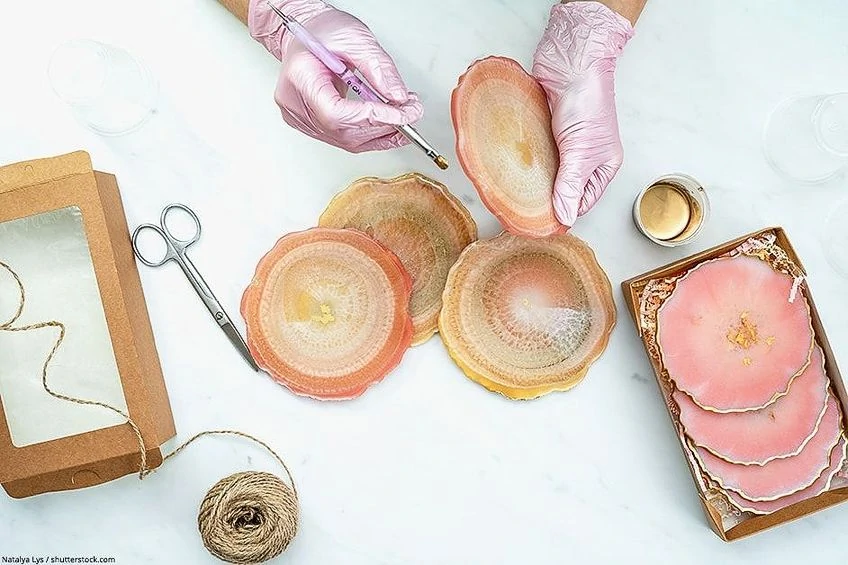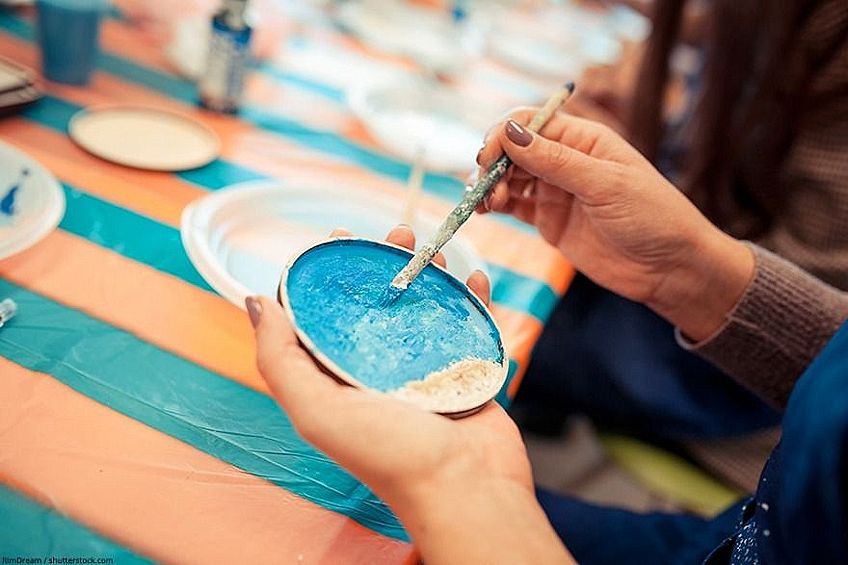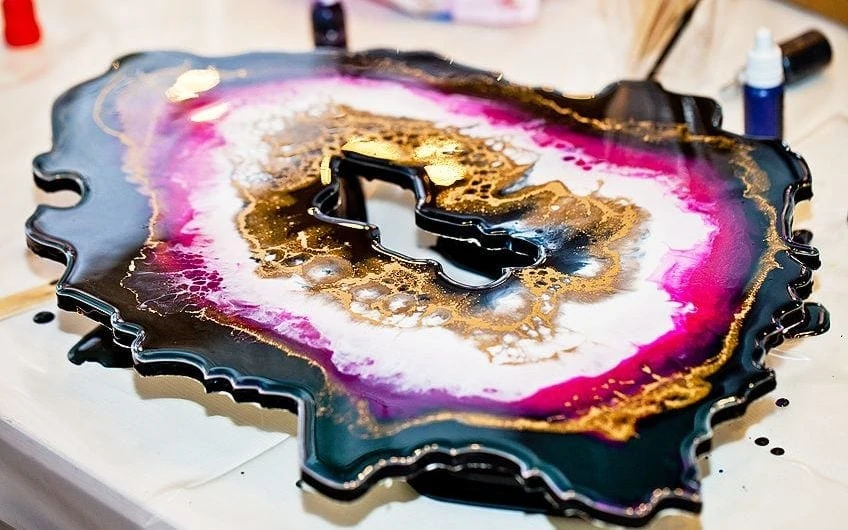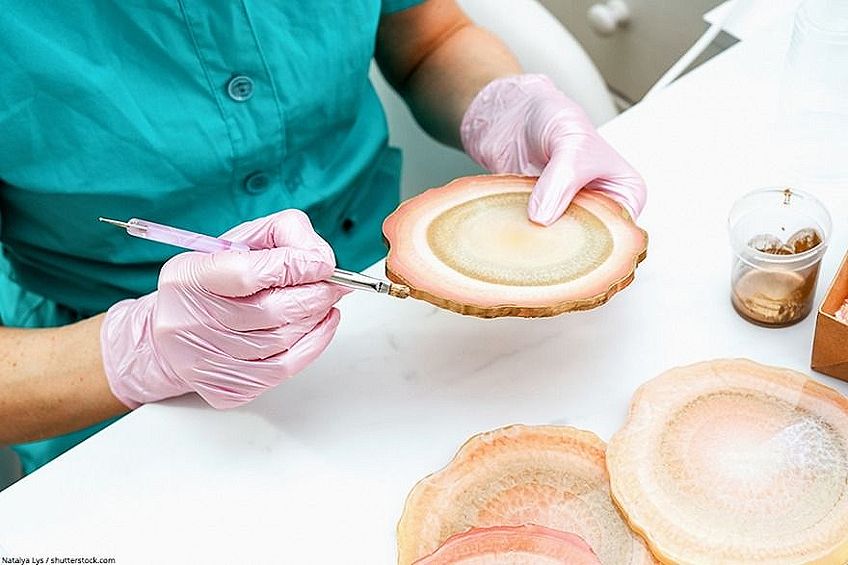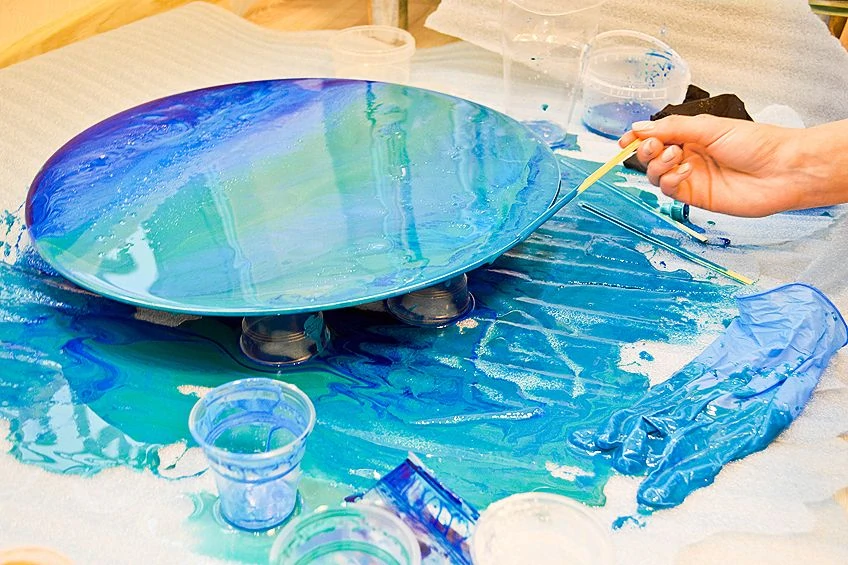Painting on Resin – Tutorial on How you can Paint Resin properly
This post may contain affiliate links. We may earn a small commission from purchases made through them, at no additional cost to you. You help to support resin-expert.com
Painting resin is a totally different experience to traditional painting surfaces – such as canvas or paper. The big difference is that resin is incredibly smooth which makes it difficult for paint to stick firmly to its surface. If you are interested in painting on resin, then be sure to check out the following guide for some useful tricks to help get a great finish.
Table of Contents
Painting Resin
Painting on resin is no easy task to get right. However, the smooth and unique surface for painting does allow you to achieve some creative and fun new effects. A beneficial technique when painting on resin is that wet paint can be easily wiped away, and dried paint can be scraped off without any problems. This gives you more room for experimenting and getting things just the way you want them.
How to Paint Resin: Step-by-Step Guide
When you paint resin, the process is different from painting on traditional surfaces like a canvas. For this reason, a few critical steps need to be followed in order to make sure you get good results. This starts by preparing the resin surface properly and then using the right type of paint for the project.
Cleaning the Resin
The first thing to do is to make sure that the surface of the resin is clean. Sometimes, there will be some dirt or residue remaining from the casting process. Using warm soapy water, you can clean up the resin pretty easily. Make sure that it is completely dirt and dust-free before proceeding.
Sanding
When the resin is cast, flash can occur. This is when some pieces of dried resin can find a place between the halves of a mold. When this happens you often don’t notice it, but it is easily spotted when painting on resin. Flash can be removed with a craft knife, and the resin surface should be sanded down completely. The smoother and more even the resin is the better.
Fill in Holes
If there are any imperfections in the resin that occurred during the casting process – such as air bubbles or holes, these will need to be filled in. Epoxy putty can be used to do this, as it will bond well with the resin. Once cured and filled in, you can sand down the putty to achieve a perfectly smooth and even surface.
Priming
Once the surface is smooth, clean, sanded, and ready, you will have to apply a layer of primer. This is necessary for painting on resin, as the resin is such a smooth surface. Without a primer, the paint will not be able to adhere very well to the resin. Making sure that the primer is on properly is one of the most important steps when you paint resin models.
You can get primers in various colors. This should be chosen depending on the color you will be painting with. Light colors are best with a light primer, dark colors work with a dark primer, and so on. Usually, white or grey primers are preferred as these work with most paint colors.
Primers can come in a spray or brush-on form. Spray on primers are best, as these allow you to get a perfectly even coating. They are also good for getting into any details and hard to reach places. Spraying on the primer offers you more control and results in a smoother finish compared to brushing it on.
Primers should be sprayed in a well-ventilated area as they can cause some fumes in the air. You will probably need a few layers of primer depending on the particular conditions. Just make sure that each coat is dried properly before a new layer of primer is added. Many people will and the primer between coats for a stronger finish.
Best Primer to Use: KRYLON ColorMaster Paint and Primer
If you are after the best primer for painting on resin, we would have to recommend this option by Krylon. This versatile primer is available in various colors, and so it can work well for all kinds of projects. This is also a spray primer which makes it a smarter choice for using over resin surfaces. This is a fast-drying primer which makes it easier to add multiple layers. It will help to smooth out uneven surfaces and increase the adhesion properties of any surfaces. If you are going to paint resin models, this primer will provide a major help.
- Fast-drying, high-solids formula that provides quick coverage
- Excellent weather ability and superior adhesion
- Smooth finish, ideal for indoor and outdoor projects
Painting Resin
Now that the resin is prepared and ready, it’s time to start applying the paint. First off, what kind of paint to use on resin? Acrylic is definitely the best option here as it adheres well and offers good versatility. When you start painting on resin, you might find that some colors don’t create a very good opaque color. This can change with different types of acrylic paints, but you will likely have to paint a number of layers for solid coloring. When doing this, make sure that the paint is fully dry before applying the next layer. Just be cautious when doing this to avoid any scratches or paint chipping off.
Best Paint for Resin: WINSOR & NEWTON Galeria Acrylic Paint Set
If you will be painting on resin, then this acrylic paint by Winsor & Newton is a perfect choice. This has got to be the best paint for resin thanks to its thickness and high level of pigmentation. This allows you to get stronger colors and better opacity on the smooth resin. These acrylic paints are designed for beginners, although the paints do have an amazing pigmentation quality. This can be compared to artist-quality paints. This allows you to get good coverage over the resin while having the colors really show through. This set of paints also offers great value for money.
- High-quality acrylic paint that delivers professional results
- Ideal for artists who want good quality colour at an affordable price
- High levels of pigment strength, opacity and permanence
Sealing
Resin surfaces can look amazing, but they don’t always hold paint as well as canvas. Because of this, resin paintings should be maintained with a sealing layer. This can be done with a lacquer sealer. This will add a protective coating against scratches, UV resistance, and any potential damages.
Best Lacquer Sealant: KRYLON Clear Glaze Aerosol Spray
This versatile finish works really well over different surfaces – including metal, wood, plastic, paper, and of course resin. This is a thick lacquer, and a single coat is often all that is needed. It dries quickly and to a clear, attractive finish. Thanks to the clear thickness, this lacquer will protect your painting as well as adding some real depth to the painted resin.
- Extra high gloss, quick drywithin 15 minutes
- Does not crack, very durable
- Permanent finish
How to Paint Resin Models
Painting a flat resin surface is one thing, but when painting on resin models you are faced with a whole new challenge. This is because of all the fine details and odd shape of resin models. When preparing resin models, the same preparatory steps need to be followed. Clean the model, prime it, and have it ready for painting. Here are some extra tips to help make a painting on resin models easier.
- Start painting the larger surfaces and then move onto smaller details. Models can have many fine details, so getting them painted properly is important. Make sure to get the right brush. A small and flat brush will help to get the finer details without leaving any brush marks.
- You should also start with lighter colors and move on to darker shades. This is because making colors darker is easy by just painting them over in a darker shade, but painting colors lighter is more difficult. This works out because the darker colors usually end u[p in the smaller, detailed places anyway.
- Finally, end the model painting off with a very fine brush. Use it to get to the smallest details and definitions of the model. It is the final little dark lines, shadows, and details that will really give the model its character. Once dried, finish the model off with a suitable sealer, Using a spray-on version is definitely recommended for the small and uneven figure.
Painting on Resin Tips and Tricks
When you paint resin there are quite a few different skills to use. Besides the general step by step guide, here are some useful tips for making resin painting more effective.
Get the Right Paintbrush
The right paintbrush makes all the difference when you paint resin. The type you use should depend on the size of the project and the kind of details you want to achieve. It is best to have a range of brushes to choose from – including a small round brush, a flat brush, and a larger brush. Synthetic brushes work well over resin and are long-lasting.
Have Patience
You will need patience when painting on resin, as it is a time-consuming process. There will likely be many layers involved, with the paint having to dry between layers. Applying lots of thin layers achieves the best finish on resin, so take your time and be patient.
Work Safely
Painting on resin will require the use of an aerosol primer and a spray-on finish. You will need to be careful when using these as there can be many fumes involved. Always spray somewhere with plenty of airflow and ventilation – ideally outdoors.
Paint Between Layers
Painting on resin allows you to experiment with different techniques and styles. One of these is adding paint between layers for a unique look and texture. You can also enhance the texture by pointing over other things, like glitter or flowers. Just make sure that the paint is dry before starting the next coat.
Room for Mistakes
Using acrylic paints on resin is really forgiving because no mistake is too critical. Wet and dry paint can be wiped and scraped off easily. This allows you to be bold, experiment, and try new techniques. You can always just wipe it clean and start again if you are unhappy with the result.
Use Empty Spaces
When painting on resin, leaving some spaces empty without any paint can create a wonderful effect of depth. Experimenting with this is a great idea – particularly if you will be doing painting between layers effect.
Frequently Asked Questions
What Kind of Paint to Use on Resin?
The best option is acrylic paint. This is the most effective over epoxy resin, and it is an affordable choice. Latex paints can also work well. Try to avoid using oil-based paints, because these do not stick very well to the resin and require a long drying time.
Can Resin and Acrylic Paints be Mixed?
Mixing resin with acrylic paint is not a good idea. Acrylic paint is water-based and will not mix properly into the resin. You can rather use a special pigment powder or resin dye for this purpose.
Can You Paint Resin?
Resin is a good surface for painting, and it can allow you to achieve some interesting effects. You should do this with acrylic or latex paints, and will need to prime the surface properly first.
Can Resin Be Set Over Paint?
This is a good way to create a durable, glossy clear finish over paint. Simply pouring mixed resin over the paint and leaving it to set will allow you to achieve a strong protective coat that looks great.
How to Add Color to Resin?
Resin can be colored with a variety of different products. It is best to use pigment powders or special resin color dye. You can also use things like shadow powder, chalk, alcohol inks, and glitter.
If you were wondering “can you paint resin?”, then this complete guide should have cleared everything up. This is useful for knowing how to paint resin models, or for creating artworks on a unique surface. Painting resin is a rewarding process that can produce one of a kind results. Follow the steps above and you will achieve a perfectly painted resin surface.


